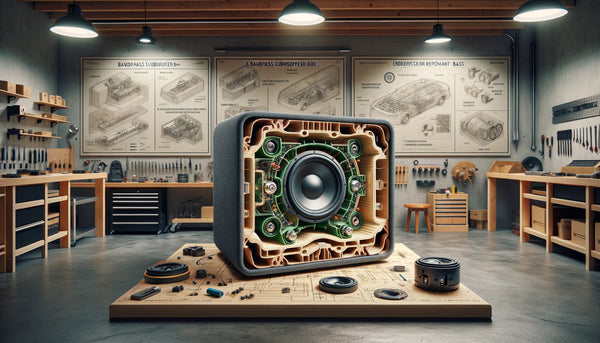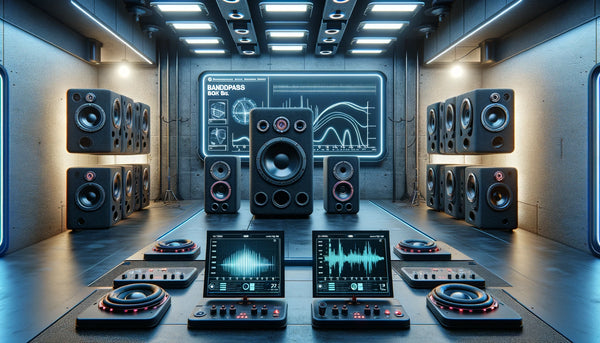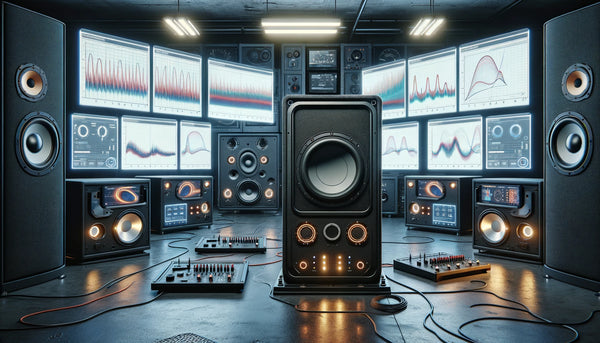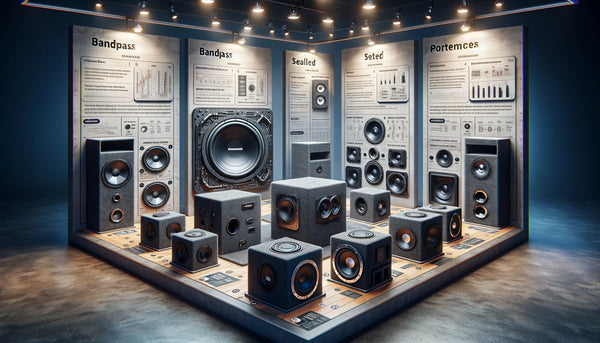If you're passionate about achieving the ultimate bass experience in your audio setup, then our in-depth exploration of the bandpass subwoofer box is precisely what you need. This detailed guide will walk you through bandpass subwoofer box design nuances, highlighting the benefits and potential drawbacks. We'll also delve into the various models available, key design factors to consider, and how these specialized enclosures stack up against alternative sound box options.
Diving into bandpass subwoofer box technology, we aim to uncover the secrets behind its ability to deliver exceptional low-frequency bass extension. By the end of this guide, you'll understand how these enclosures work and why they might be the perfect addition to elevate the bass in your audio system. Whether you're an audiophile or a casual listener, the insights provided here will empower you to decide on enhancing your sound setup with a bandpass subwoofer box.
Understanding Bandpass Subwoofer Box

Before we delve into the details, let's establish a solid understanding of a bandpass subwoofer box. A bandpass subwoofer box, also known as a subwoofer enclosure, is specifically designed to emphasize low-frequency sound waves, particularly bass. By using a dual-chamber design, with the subwoofer mounted inside the Enclosure, bandpass subwoofer boxes can enhance the bass response of your audio system. These enclosures, also known as bandpass boxes, are engineered to optimize the reproduction of low frequencies, providing deep, impactful bass for an immersive audio experience.
What is a Bandpass Subwoofer Box?
A bandpass subwoofer box combines the best of both worlds, offering exceptional bass extension and volume. It features two chambers, the front and rear, which work harmoniously to deliver powerful low-frequency output. The subwoofer is mounted inside the box, and the front chamber is acoustically coupled to the listening area, enhancing the bass response. This design allows the subwoofer to operate efficiently, focusing on specific low frequencies for optimal sound quality. The front chamber also acts as a kicker, delivering an extra punch to the low-end frequencies for a more dynamic listening experience.
One of the key advantages of a bandpass subwoofer box is the ability to customize the enclosure size, tailoring it to the specific bass performance requirements. By carefully tuning the front chamber volume and the port size, the bandpass subwoofer box can be optimized to deliver deep bass extension and high sound pressure levels.
How Does a Bandpass Subwoofer Box Function?
Understanding how a bandpass subwoofer box functions is essential in realizing its full potential. When the subwoofer cone moves, it generates air pressure directed into the ported chamber of the bandpass subwoofer box. This rapidly changing airflow helps produce bass extension, allowing deep low-frequency reproduction. The bandpass system, consisting of the subwoofer, Enclosure, and ported chamber, is carefully tuned to emphasize specific low frequencies while limiting the woofer excursion.
By design, bandpass subwoofer boxes provide excellent power handling capabilities, imposing limits on the woofer excursion. This results in enhanced durability and more efficient bass reproduction. The functionality of a bandpass subwoofer box ensures that the low-frequency sound waves are focused, delivering impactful bass within the desired frequency range.
What are the advantages of using a bandpass subwoofer box compared to other types?

Bandpass subwoofer boxes offer several advantages over other types. They provide higher efficiency, power handling, enhanced bass response, and deeper lows. Additionally, bandpass enclosures can help protect subwoofers from damage by providing a controlled environment for the speaker.
The Pros and Cons of Bandpass Subwoofer Box

Now that we have a basic understanding of bandpass subwoofer boxes, let's explore the advantages and disadvantages of these enclosure systems. It is essential to consider the benefits and drawbacks of incorporating a bandpass subwoofer box into your audio setup.
Advantages of Using Bandpass Subwoofer Box
Bandpass subwoofer boxes offer several advantages, making them an appealing choice for audio enthusiasts. These advantages include:
- Superior Bass Extension: Bandpass subwoofer boxes are designed to provide deep bass extension, enhancing the low-frequency reproduction in your audio system.
- High Sound Pressure Levels (SPL): With the ability to achieve high sound pressure levels, bandpass subwoofer boxes create a more immersive audio experience, filling the room with powerful bass.
- Efficient Power Handling: The design of bandpass subwoofer boxes allows for efficient power handling, resulting in impactful bass output with lower distortion.
- Tight Transient Response: Bandpass subwoofer boxes are engineered to optimize the transient response, ensuring accurate and tight bass reproduction.
A bandpass subwoofer box can enhance your audio system's bass performance, creating a more immersive listening experience.
Disadvantages of Using Bandpass Subwoofer Box
While bandpass subwoofer boxes offer notable advantages, it's essential to consider the potential drawbacks associated with their use. These disadvantages include:
- Enclosure Size: Bandpass subwoofer boxes tend to be more extensive than other enclosures, which may pose challenges in terms of installation and compatibility with limited space.
- Customization: Achieving optimal bass performance with a bandpass subwoofer box often requires customization, which may involve additional time, effort, and resources.
- Frequency Response Limits: Bandpass subwoofer boxes are specifically designed to emphasize specific low frequencies, which can result in limitations in the overall frequency response of the audio system.
- Potential Durability Concerns: The design of bandpass subwoofer boxes, with the subwoofer exposed to the front chamber, may require careful consideration to ensure durability and protection of the subwoofer.
- Understanding these potential drawbacks will help you make an informed decision when considering a bandpass subwoofer box for your audio system.
As we explore the world of bandpass subwoofer boxes, we must note that different types are available, each with unique design and characteristics. Let's delve into the two common types of bandpass subwoofers: single-reflex bandpass and dual-reflex bandpass.
Single Reflex Bandpass Subwoofer Boxes
Single reflex bandpass subwoofer boxes utilize a ported chamber, commonly known as the front chamber, to direct the cone motion of the subwoofer. This type of design allows for deep bass extension, emphasizing lower frequencies. The ported chamber optimizes the airflow and pressure within the Enclosure, resulting in enhanced bass reproduction. Single reflex bandpass subwoofer boxes are known for their efficiency in power handling, making them an excellent choice for audio enthusiasts seeking an impactful bass response.
Dual Reflex Bandpass Subwoofer Boxes
Dual reflex bandpass subwoofer boxes take the design of single reflex bandpass subwoofer boxes one step further. With dual reflex bandpass subwoofer boxes, there are two ported chambers, allowing for even greater bass response and improved audio quality. This design increases the volume of sound waves the subwoofer generates, enhancing bass extension and efficiency. The dual reflex design allows audio enthusiasts to achieve a more dynamic listening experience with a deep, impactful bass. The ported chambers in dual reflex bandpass subwoofer boxes work harmoniously, maximizing the volume of sound waves and optimizing the low-frequency response.
Bandpass Subwoofer Box Design Considerations
When designing a bandpass subwoofer box, several important considerations come into play. These factors include enclosure design, sound wave interference, and the acoustic challenges of the system. By addressing these design considerations, audio enthusiasts can optimize the performance of their bandpass subwoofer box, ensuring exceptional bass quality and sound reproduction.
Enclosure and Sound Wave Interference
The design of the Enclosure plays a crucial role in minimizing sound wave interference within the bandpass subwoofer system. By carefully considering the enclosure design, audio enthusiasts can ensure that the sound waves generated by the subwoofer are optimized for the best bass response. Additionally, considering the listening area and the placement of the bandpass subwoofer box within the room can further enhance the overall sound quality and bass performance. Proper enclosure design, sound wave interference management, and a powerful amplifier are essential for optimal bass extension and sound reproduction.
Acoustical Challenges
Bandpass subwoofer boxes present unique acoustical challenges, including displacement, which must be addressed for optimal sound quality and bass performance. These challenges include transient response, frequency response, and excursion limits. By effectively understanding and tackling these challenges, audio enthusiasts can ensure the bandpass subwoofer box system delivers exceptional audio performance. Achieving deep bass extension, accurate sound reproduction, and managing excursion limits are critical factors in designing bandpass subwoofer boxes that fulfill the demands of audio enthusiasts.
Sealed vs. Ported Chambers in Bandpass Subwoofers
In the design of bandpass subwoofer boxes, the choice between sealed and ported chambers plays a significant role in bass extension and sound quality. Let's explore the distinct roles of these chamber types in bandpass subwoofer box design.
The Role of Sealed Chambers
Sealed chambers in bandpass subwoofers play a crucial role in achieving tight bass response and transient accuracy. The sealed chamber's design helps control the airflow and cone motion of the subwoofer, resulting in quality bass extension and precise sound reproduction. Using sealed chambers, audio enthusiasts can ensure the bandpass subwoofer box system produces distortion-free bass, enhancing the listening experience.
The Function of Ported Chambers
Ported chambers, conversely, are integral to bandpass subwoofer box design, as they contribute to bass extension and efficiency. The ported chamber allows for the controlled release of air, enhancing the low-frequency response of the subwoofer. By optimizing the size and design of the ported chamber, audio enthusiasts can achieve deep bass extension while maintaining efficiency in power handling. Utilizing ported chambers in bandpass subwoofer boxes results in extended frequency response and an enhanced audio listening experience.
Bandpass Subwoofer Box Vs Other Sound Boxes

When comparing bandpass subwoofer boxes to other sound box designs, such as closed-box and vented enclosures, it is crucial to consider each system's unique characteristics and benefits.
Comparison with Closed-box (sealed) Enclosure
Closed-box enclosures, also known as sealed enclosures, are designed to provide precise sound quality by controlling the airflow and motion of the subwoofer. While they may offer accurate sound reproduction, closed-box enclosures can limit bass response, especially in lower frequencies. Bandpass subwoofer boxes, emphasizing deep bass extension, often surpass the bass performance of closed-box enclosures while still maintaining sound quality. Additionally, bandpass enclosures utilize sealed and ported designs, providing a unique suspension system for the subwoofer.
Is a Bandpass Subwoofer box better than a Vented (reflex/ported) Enclosure?
In comparing bandpass subwoofer boxes and vented enclosures, bandpass subwoofer boxes offer several advantages. Bandpass subwoofer boxes enhance sound pressure levels and greater frequency bandwidth, improving low-frequency performance. The design of bandpass subwoofer boxes allows for more dynamic bass response compared to vented enclosures. While vented enclosures may offer some advantages in specific audio applications, bandpass subwoofer boxes deliver deep, impactful bass and a more comprehensive frequency response range.
Conclusion

In conclusion, the bandpass subwoofer box is a popular choice for car audio enthusiasts looking for powerful bass and efficient use of space. It offers advantages such as increased output, enhanced sound quality, and a compact design. However, it's essential to consider the potential drawbacks, such as reduced frequency response and complexity in design. When choosing between different types of bandpass subwoofers, such as single or dual reflexes, it's essential to understand their unique characteristics and how they interact with your car's acoustics. Additionally, comparing bandpass subwoofer boxes to other sound boxes, like sealed or vented enclosures, can help you decide based on your audio preferences and space limitations. Ultimately, whether you opt for a bandpass subwoofer box or another type of Enclosure, it's crucial to prioritize quality components and professional installation for optimal performance.





